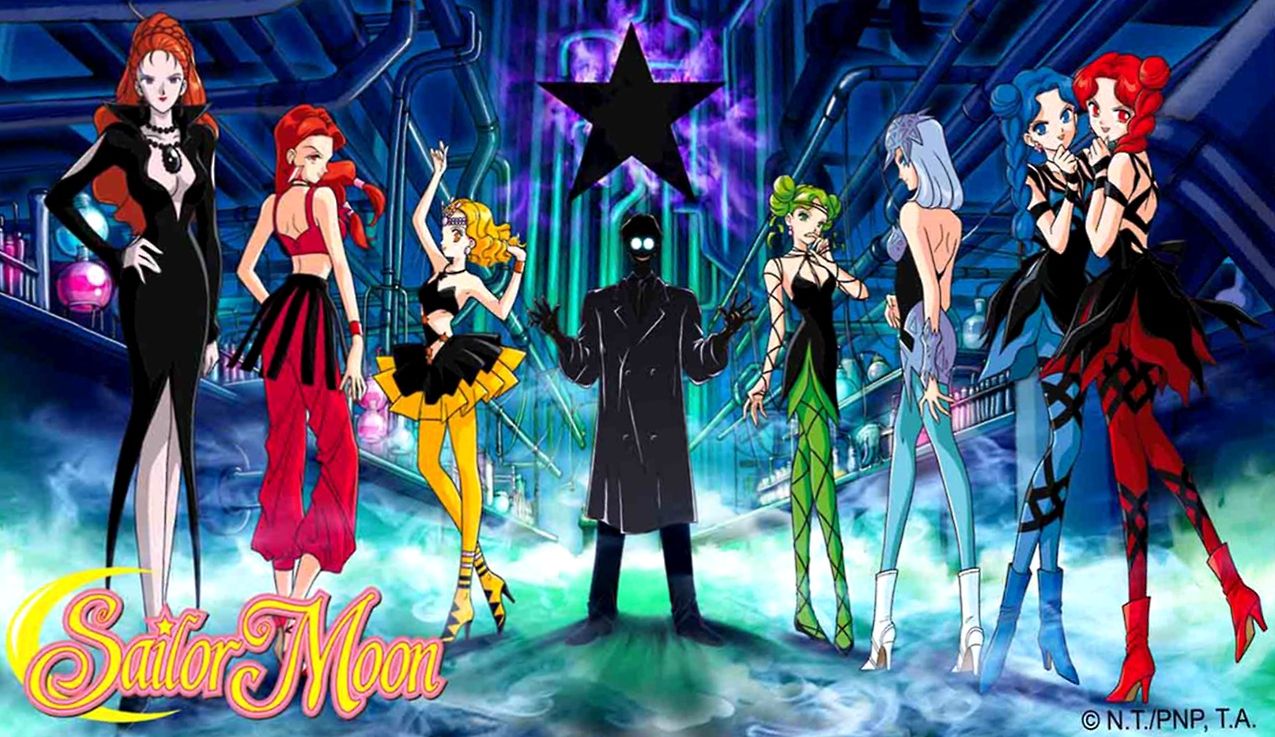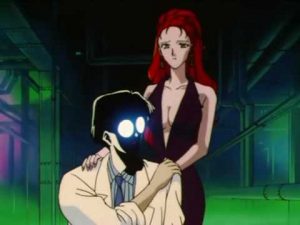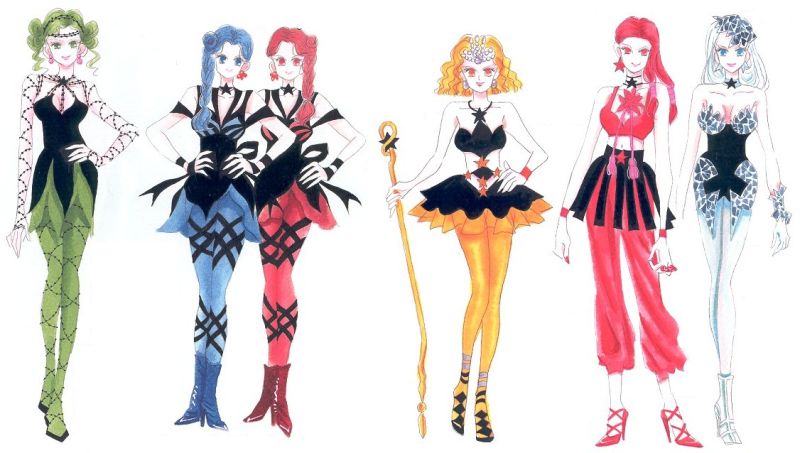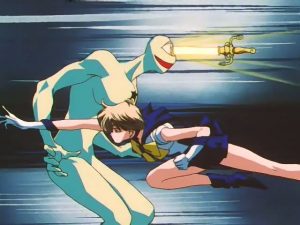It seems that this question comes up at least once every season, but it’s just too much for me to pass up on the opportunity to discuss the depth that Ms. Takeuchi goes to when naming her characters. And that’s saying nothing of the entirely different styles of pun-tastic names that the anime producers went with when naming their various youma, cardians, droids, daimons, and other monsters of the day. Now that the Death Busters have made their long-awaited appearance in the Sailor Moon Crystal anime, it seems like now is as good of a time as ever to discuss how it is that they characters got their names. So what was the inspiration behind the names of the Witches 5 and the other members of the Death Busters?
Fortunately, Ms. Takeuchi doesn’t disappoint. As with her earlier seasons, she continues with the consistent theme of naming all of the enemies after gems and minerals. Though we know that Ms. Takeuchi has a strong academic background in both astronomy and chemistry,1 judging by the constant re-use of the theme, it seems that mineralogy is something of a hobby of hers.
This probably shouldn’t come as much of a surprise seeing as she was born in Kofu, Yamanashi – the self-proclaimed “Crystal Town.”2 Indeed, there are over 1,000 companies and tradesman working in the jewelry industry in Kofu, with over 30% of the jewelry in Japan coming from there.3 What’s more, her cousin actually owns a jewelry shop!4
So now that we got that out of the way, let’s take a look at the Death Busters!
- Professor Souichi Tomoe: My gut feeling is that, more likely than not, the last name Tomoe was chosen for its relevance to Hotaru and that her father wasn’t much of a consideration when the name was chosen. As for his first name, Souichi, it’s written using the kanji 創一 which, when taken individually, mean to found / establish (創; sou)5 and one (一; ichi)6 respectively. This is likely in reference to his being the founder of Mugen Gakuen in the manga.
- Kaolinite: Named directly after the mineral kaolinite, a very common clay mineral commonly found in Kao-ling, China, which is where it gets its name.9 There doesn’t seem to be any connection between the mineral and her personality or appearance, other than the possible reference to clay and being moldable.
- Germatoid: The being possessing Professor Tomoe and serving Pharaoh 90, his name is possibly a reference to geranium,10 which is described as “a grayish-white hard brittle metalloid element,” which fits his appearance pretty well.
- Eudial: Named after the mineral eudialyte,11 she seems to take part of her design from the mineral as well, seeing as it most commonly appears in red, magenta, and brown. The name for the mineral is derived from the Greek phrase eu dialytos, meaning “well decomposable,” due to how easily it dissolves in acids.
- Mimete: Her name comes from the mineral mimetite,12 and once again seems to have been inspiration for her character design, seeing as the mineral itself also comes in various shades of yellow, orange, and brown. The name comes from the Greek word mimetes meaning “imitator,” which would explain her use of costumes.
- Tellu: Though it’s pretty clear that her name comes from the mineral tellurite,13 this unfortunately seems to be where the comparisons end.
- As an interesting aside (though likely unrelated), if you combine tellurium (the element, not the mineral) with gold or silver, you’ll end up with petzite or calaberaite, respectively!
- Viluy: Another case where the mineral and the appearance don’t seem to be related, her name comes from the mineral wiluite/viluite.14
- Ptilol: Her name is derived from the mineral known as ptilolite and most commonly found under the name clinoptilolite.15 It can be found in a variety of colors, including a deep red,16 which is probably the inspiration for her character design.
- Cyprine: One of the most straight-forward connections, her name is a reference to the mineral cyprine,17 which is can appear bluish in color. Once again, another character connected between name and design!
That brings us to an end for the origins of the names for the Death Busters, but I have to say that I’m definitely glad to see that Ms. Takeuchi not only maintained consistent themes for characters and designs for each season, but still managed to pay homage to the older seasons as the series progressed by using mineral names for the enemies while reserving elemental and planetary names for the Sailor Soldiers.
It’s just a shame that much of the meanings in kanji are lost in translation. What do you think is better? Translating for meaning, or just romanizing the name for pronunciation? I’d love to hear people’s thoughts!
References:
- See Naoko Takeuchi (Wikipedia) ↩
- See the Yamanashi Crystal Counsel Homepage ↩
- See History of Jewelry in Yamanashi ↩
- See vol. 4, p. 194 of the original manga ↩
- See 創 meaning (Jisho.org) ↩
- See 一 meaning (Jisho.org) ↩
- See 螢 meaning (Jisho.org) ↩
- See 子 meaning (Jisho.org) ↩
- See Kaolinite ↩
- See Geranium ↩
- See Eudialyte (Wikipedia) ↩
- See Mimetite (Wikipedia) ↩
- See Tellurite (Wikipedia) ↩
- See Wiluite (Wikipedia) ↩
- See Clinoptilolite (Wikipedia) ↩
- See Clinoptilolite Images ↩
- See Cyprine (Mineral) (Wikipedia) ↩





Whilst we’re on the subject, what exactly is the significance of the name ‘Death Busters’ anyway?
Or is it merely a case of throwing random English words together that sound cool, which the Japanese are often fond of doing.
Probably play on the term “Ghostbusters,” seeing the connection between ghost -> death and… well, busters? It’s not the only time for “busters” to appear in Japanese media, either, though I can’t find any that pre-date the release of Ghostbusters in Japan.
Other notable ‘Busters:
1992 TV program “KATO & KEN Television Busters”
1995 Company named “Media Busters”
1997 TV program “Digital Magazine Busters BS”
So, yeah, my best guess is that it’s just a Ghostbuster parody!
I remember back in the day reading an extensive essay on Ptilol over at Dies Gaudii which I think concluded the same inspiration. Been a long while since I visited that site… So nice to be reading academic-styled thoughts on Sailor Moon again instead of the mass chunk of the Internet devoted to “who’s your favourite Senshi, guyz?!” and similar superficial discussions.
Thanks for your hard work!!
Thanks for the comment! Dies Gaudii… wow, that really brings back a lot of memories from the ooooold days of Sailor Moon fandom on the internet, back before I could even read Japanese. I definitely need to look through the site again one of these days (though I think we disagree on some points, but that’s what makes academic debates fun!).
Ultimately, I’m just fortunate that Ms. Takeuchi and the anime staff went so far to fill the series with so much meaning. The digger you deep, the more you find!
Oh! Oh! I can help you here!
You see, Tellurite comes from the Latin word tellus, earth. There’s even an obscure English word tellurian meaning “of or inhabiting the earth.” Tellu has plant-based powers and a plant-based look, and that connects her to the earth.
As for viluite/wiluite, it’s confusing because BOTH spellings have been used to refer to two different minerals, one of which is also called grossolite. The other one, though, has a marked resemblance to her design (https://www.mindat.org/min-7367.html).
Kaolinite is trickier to connect, but I do read that it is sometimes rust-colored due to iron oxide concentration. Example: https://www.minerals.net/thumbnail.aspx?image=MineralImages/kaolinite-pseudomorph-monte-somma-vesuvius-italy.jpg&size=500 .
I don’t know if it was intentional or not, but the Wilui/Vilyui River region, after which the mineral wiluite was named, is – at least in Russia – surrounded by urban legends about it being visited by aliens (these mostly come from interpreting gigantic cauldrons buried around the river in the local myths as abandoned/broken “flying saucers”). Given the “alien” theme of enemies in S, Viluy has quite a fitting name.
I always figured Germatoid’s name was also in reference to germs as he infected Tomoe